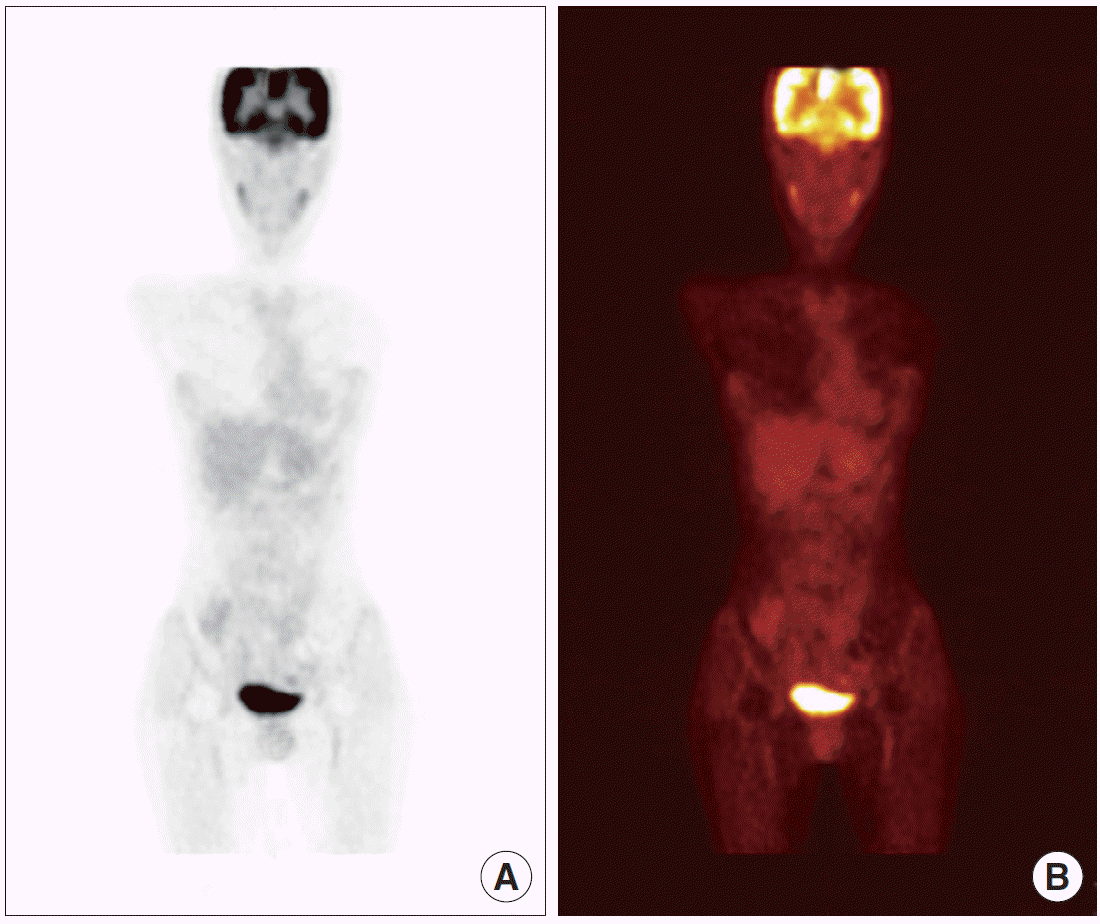Misdiagnosed Rhabdomyosarcoma of the Vulva
Article information
Abstract
Vulvar carcinoma is a rare disease that accounts for 5% of gynecologic cancers. Sarcomas of the vulva are extremely rare, and account for only 1% to 3% of all vulvar malignancies. We report of a case of a 26 years woman with a vulva mass. Excision was done and histopathologic result showed rhabdomyosarcoma.
INTRODUCTION
Among vulvar malignancies sarcomas are mainly uncommon diagnoses. Most of the vulvar neoplasms are represented by squamous cells carcinoma [1]. The most common vulvar sarcomas are leiomyosarcomas, rhabdomyosarcomas, angiosarcomas, neurofibrosarcomas, and aggressive angiomyxoma [2,3]. Median age at diagnosis is 50 years. Lesions are frequently misdiagnosed as Bartholin’s cysts or abscesses, and the most common presenting symptom is local discomfort with a vulvar mass, chronic vulvar pruritis, or both, and pain with intercourse [3].
We experienced that a 26-year-old woman who had a vulvar mass visited Soonchunhyang University Gumi Hospital. At first, this vulvar mass diagnosed a benign lesion but the result of mass excision revealed vular rhabdomyosarcoma.
CASE REPORT
A 26-year-old woman presented a lump in the vulvar associated with progressive difficulty in urination that had persisted for approximately half a year. A diagnosis of Bartholin’s abscess had been made in another hospital. On gynecological examination, vagina, cervix, and uterus appeared normal, but a 7×4 cm firm, hard, painless mass was found in the left labium major. There were no other significant findings in her present or past medical history. During first two weeks we had used antibiotics, but there was no change in size and pelvic magnetic resonance imaging or position emission tomography-computed tomography revealed that there was no lymphadenopathy (Figs. 1, 2). Excison biopsy were performed that mass size was 5×4×3 cm (Fig. 3). The pathohistological result was found rhabdomyoblastic differentiation and confirmed vulvar rhabdomyosarcoma (Fig. 4). Now the patient has done radiotheraphy.
DISCUSSION
The vulvar tumors are benign in 98% of cases with 2% reported as malignant [4]. The differential diagnosis includes fibroma, lipoma, papilloma, hidradenoma, epidermal cyst, Bartholin cyst, and melanoma [4].
Sarcomas are rare tumors (1% to 2% of all cancers) of mensenchymal origin that may develop in soft tissues and viscera [3]. Primary soft-tissue sarcomas account for less than 2% to 3% of all malignant tumors occurring in the female genital tract [3]. The most common gynecological sarcoma is uterine sarcoma (90% of cases) [5]. Other gynecological sarcomas include vulva, vagina, ovary, fallopian tubes, and uterine ligaments sarcomas (10%) [5]. Invasive vulvar carcinoma accounts for about 5% of gynecologic cancers and sarcoma of vulvar are extremely rare [3].
Leiomyosarcoma constitutes 1% of all vulvar malignancies [6]. The criteria for predicting malignancy in vulvar smooth muscle tumors include the presence of at least three of the following: infiltrating margin, size of 5 cm or greater, moderate to severe cytological atypia, and presence of five or more mitotic figures per 10 high power field [6]. Radiation does not appear to affect survival but it has a tumor-reducing effect [7]. Chemotherapy occasionally provides significant improvement in survival and quality of life in patients with leiomyosarcoma of soft tissue [7].
Rhabdomyosarcoma is a rare malignant soft tissue neoplasm comprised of cells derived from the primitive mesenchyme [8]. About 35% of rhabdomyosarcoma arises in the head and neck [8].
They are classified histologically into Embryonal, Botryoid, Alveolar, and Pleomorphic varieties, and tend to occur predominantly in three regions: the head and neck, genitourinary tract, and upper and lower extremities [8]. This is the most common soft-tissue sarcoma in chidren, comprising 5% to 8% of all childhood malignancies [9]. Approximately 15% to 20% of rhabdomyosarcoma are genitourinary in origin [10]. It presents a fascinating array of histologic aspects that feature the cytologic stages of myogenesis and the interaction of neoplastic rhabdomyoblasts with the adjacent connective tissue matrix [11]. The first line of treatment is radical excision and this is usually supplemented by radiotherapy [8]. It is believed that adjunct combination chemotherapy may greatly improve the prognosis [8].
We described patients with rhabdomyosarcoma and a vulvar lump. This rare case was initially misdiagnosed because of the nonspecific clinical and histopathological findings. The combination of clinical history, histopathology, immunohistochemistry, and radiologic test is essential for making the proper diagnosis.



